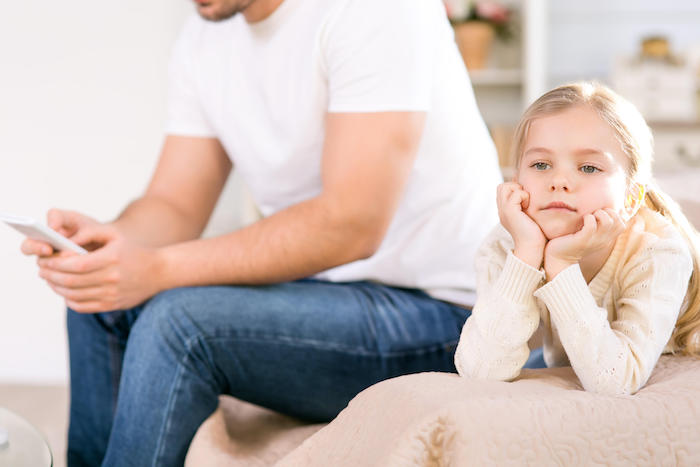With screen time replacing connection and conversation, separation and skills are compromised. Now more than ever, it’s time to resist the urge to be 24/7 plugged in.
Step Away from The Phone & Here’s Why
Humans are biologically, cognitively, physically, and spiritually wired for connection. Every person wants to love, be loved, and belong. The biggest problem in most people’s lives today are their devices. Most don’t recognize this to be the problem, but it is problematic.
People complain an awful lot about how difficult it is to get their kids to put down their phones, but let’s be honest – most adults have the same difficulty disconnecting from technology. From friendships to marriages, devices are becoming a barrier, and even a problem. It’s not hard to find evidence of phones and devices taking priority over real connection and conversation. The next time at a restaurant, take a look around, chances are people, including couples, will be on their phone. They can be sitting directly across from each other, face-to-face, yet staring down at their screens.
People are struggling today more than ever before, especially kids. From children to adolescents, they are presenting with concerning behaviors such as struggling to make eye contact, poor coping skills, difficulty forming relationships, lack of motivation and interests outside of their devices. This is a problem because if kids spend most of their time connecting and communicating primarily through devices and not face-to-face, the brain may not further develop the neural pathways that are a vital part of human development regarding the ability to connect and communicate with others.
The prefrontal cortex of the brain is not completely developed until most people are in their 20’s. This part of the brain is responsible for the ability to think things through, decision-making, and willpower, so the overuse of phones and devices can interrupt the development of this crucial component of cognition. It is also a concern that children will become addicted to their devices because there is a biochemical reaction taking place when they get a text or notification. This biochemical reaction occurs in children, adolescents, and adults, however, the younger it starts, the more problems it can cause.
Every time the phone beeps with a new text or notification, the brain lights up and releases chemicals like dopamine and serotonin. Because of this, people are constantly distracted and struggling to stay focused and on task out of the urge to check their devices. This is no different than a person struggling with alcoholism and/or drug addiction. They experience the urge, which becomes an obsession, often leading to relapse. In this case, people attempt to put their phones down, but eventually pick them back up because of their own obsession and the need to check their texts and notifications “right now.”
It’s easy to agree, there is an overflow of entertainment and information available to people simply by picking up their phones, and because of this, people are never left to be bored and with nothing to do. While this may seem to be okay, it is actually doing more harm than good. People are no longer left to sit with themselves, to interact and engage in social settings, to experience life in their true reality, outside of the reality they live through social media, video games, and the news. Boredom or having nothing to do is actually necessary as it’s an opportunity to process, self-reflect, build creativity, and learn how to accept what is.
Here are three ways to do a Digital Detox:
- Be a leader, a good role model – be less plugged in and more present, especially if there’s children involved. Children learn from their parents and you can expect them to follow their behaviors.
- Ban devices at dinner and any tech from the table – use table time to have real face time. Whether it’s for breakfast, lunch, or dinner use that time to be present, a time to have meaningful conversations, a time to disconnect from devices, a time to just be.
- Alert friends and family – turning off the phone and devices can make it difficult to be reachable, but let friends, family, and even work know that way they don’t worry. This will allow people to have moments off their phone and devices whether it be to read a book, exercise, or enjoy the outdoors.
Meet Stephanie
Stephanie Catalano is a Licensed Clinical Social Worker, Personal Development Author, and Life Coach with experience in the fields of Child Welfare, Mental Health, and Substance Use with three published books to date. Stephanie’s mission is to empower individuals as they work towards reaching their highest potential.
To learn more about Stephanie, visit www.themindfulliving.com and follow her on Emenator @mindfulliving, Instagram @mindfulliving.now, and Facebook @mindfulliving for daily inspiration, Mindful skills, tips, and more. Find Mindful Makeover Workbook and Guide on Amazon and check out The Mindful Makeover Podcast available on iTunes and Spotify.
The Editorial Team at Lake Oconee Health is made up of skilled health and wellness writers and experts, led by Daniel Casciato who has over 25 years of experience in healthcare writing. Since 1998, we have produced compelling and informative content for numerous publications, establishing ourselves as a trusted resource for health and wellness information. We aim to provide our readers with valuable insights and guidance to help them lead healthier and happier lives.

































